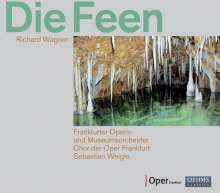Wagner was 20 years old when he composed Die Feen (The Fairies), and it is worth a listen. Here’s a bit of Weber (Oberon and Freischütz); a hint of Mozart (Zauberflöte); an effect from Beethoven’s Fidelio. Choruses are plentiful and impressive, and there is coloratura writing for the soloists ( remember, Wagner was enamored of Bellini at this point in his life). The fantastic plot has elements of the Orpheus myth in Act 3, when our tenor hero, Arindal, with harp accompaniment, brings his soprano wife, Ada, back to life through the magic of music. When he originally meets her, she is in the form of a doe; he, a mortal prince, is permitted into her world of shape-shifting fairies, providing he not ask her who she is for eight years. He cannot help himself and she is taken from him. The opera itself is concerned with them returning to one another. Shades of Lohengrin; shades of immortality through music (Wagner himself). Oh yes, and redemption through love.
The plot is sick with incantations and transformations and is better off left alone. Some of the music winds up in Rienzi (bits in the overture; parts of the first-act finale) and there are hints of other operas as well. The work is just shy of three hours; Wagner revised it in the following year but it was never performed in his lifetime (its premiere was in 1888, five years after his death). Despite some exciting ensemble work sprinkled throughout, lengthy periods of exclamation and explanation wear it down. One listen should be enough. Wagner gave the score to King Ludwig of Bavaria when the latter became his patron; it was later given to Hitler and is believed to have perished with him in his bunker in 1945.
The fine cast is led by Sebastian Weigle with a sense of occasion. Arindal, a long tenor role, is sung by Burkhart Fritz with an heroic timbre and almost enough stamina to get through the last act unscathed. As Ada, a role that will remind some of Elsa (mostly lyrical but capable of outbursts), the theatrically involved Tamara Wilson has a full, lyric soprano voice that can spin a lovely phrase as well. Brenda Rae (with whom I associate Handel’s operas) sings the part of Lora, Arindal’s sister, and she has some of the score’s finest moments. Lora’s husband Morald, who is Arindal’s friend, finds baritone Michael Nagy showing off a rich, dark sound. The others in the big, sometimes confusing cast, are all worth hearing.
There is still available (on-and-off) a wonderful performance of this opera on Orfeo from 1983 under Wolfgang Sawallisch (with the amazing Linda Esther Gray, June Anderson, and John Alexander); but since recordings of Die Feen do not come along often, that one or this one are tied for first. I can’t say that I want to hear it often—it’s too spread out, with long, long numbers and expository interactions; but it offers a true glimpse into Wagner’s creative process, especially for those very familiar with his later operas.
































